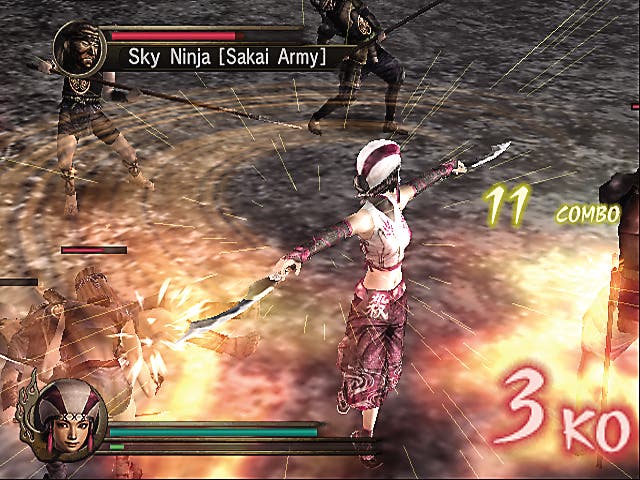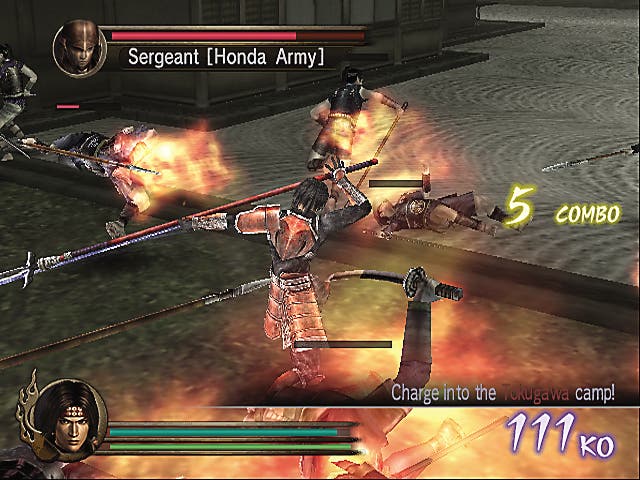Samurai Warriors
Koei takes an ailing horse and beats some life back into it. Just.
Order yours now from Simply Games.
If it’s a Koei game and the word “warriors” appears in the title, it’s going to be more fighting action than a presidential Ohio ho-down. Solo combatants surrounded by hundreds of enemies twirling spiked sticks is the mainstay of this entire series. Always in the Orient. Always historical. Always the same. Ish. With the recent dalliance of mixing a strategy underlay with the crazed combat scenario in Dynasty Warriors: Empires failed to basically “work” especially well, it’s a relief to get back to some solid, non-stop fighting in Samurai Warriors. But, if we’re being honest, we’re seriously on the verge of being all warriored out.
Samurai Warriors lets you take control of one of five hero types as they beat up a huge amount of people through an extended story mode. All these games contain largely the same elements. You find yourself on a map after viewing equipment screens, running around with soldiers allied to you (“bodyguards” in Samurai Warriors) trying to find the chap you need to kill to advance the story, or complete some other condition. You’re part of an army fighting an opposing force. Missions are either simplistic (find and kill large Japanese man) running to convoluted as you progress (guard gate against army, lure army into castle and trap, find and kill large Japanese man). It’s all played in the third-person.
Fighting is immediate and consists of measured button-bashing. X is your basic attack, Y is a charge attack and B is a Musuo attack (mentalism magic action). A jumps. A ranged attack is found on the right trigger, with the view going into a targeted first-person mode. Different characters have different weapons with varying ranges and speeds. Just as they have in all the other games in the series. You get surrounded by enemies then go beserk. Just as they have, etc.
Missions last about 10 minutes. The battlefields are huge, and various other officers in your army provide a constant commentary on the ebb and flow of the battle. “I come forth!” they shout. And they do.
Frantically kicking the horse

Unfortunately, you can beat the earlier levels by simply running to the location of the enemy officer you’re required to kill and… killing him. By the time you get there you won’t have taken much damage because nothing has time to hit you as you run past, and you’re fresh as a button for the final (only) fight. It doesn’t really matter how complex the dressing is if the salad consists of limp iceberg and moulding tomatoes. That’s not exactly a fair analogy, but you know what we mean. There are literally dozens of officers and hundreds and hundreds of troops working independently of you on the battlefield, but you just leg it across and have a fight with the big chap. At best, that’s a “flaw”. The later levels are much harder, to be fair, but Samurai Warriors is fairly basic in its core gameplay.
Once you’ve killed the large Japanese leader bloke on the opposing army, you’re presented with quite a cool running timer and pieces moving around a top-down map showing you how all the troops and officers moved during the battle on both sides. At first this looks gimmicky, but the later levels will take many attempts to complete, and a careful viewing of enemy movements before trying again is essential to success. Then it’s on to the upgrade screens.
Items such as Power Bracer (+2 attack) and Kappa Amulet (+4 luck) are acquired during fighting. Equip them, please. Instead of acquiring lieutenants as in Dynasty Warriors: Empires, your chosen combatant picks up bodyguards on the way round. Cheers. You get a screen at the end of the mission telling you your rank, your experience, your KO score, as so on. You’re also graded from A to E on the speed you finished the mission in, your item experience bonus, mission completion and Musuo KOs, getting an overall grading for the entire fight. Lovely.
Another screen then shows you where you accrued attack and defence in attributes such as melee, ranged combat, horse combat and speed (encompassing speed, jump and agility). Then, you go through to a character growth screen, where you spend skill points on Might, Prowess, Guard and Element skills. Here, you can acquire skills such as Acclaim (get more experience after battles) or combat moves like Shock, Domino and Blast. Then you save. Then you breathe. Repeat to fade.
The horse! It’s alive!

It’d be easy to dismiss the story mode at that, but there is more to it. The course your warrior takes branches cleverly depending on whether or not you accomplish goals correctly in missions. Your battle is going badly, and your leader gets assassinated. You see a CG story sequence with him dying and giving your character final orders. Your mission changes (such as to defend the camp and kill the main officer of the opposing army as he starts a counter attack, learning of the death of your head honcho). You win. Because your chap was killed, the story sends you down another path after the victory. You click on the appropriate map and the appropriate story rolls. To see the other levels, you obviously have to complete the missions within the original mission parameters. The way it offers you this “third way” is smart, and adds replay value. All missions can be replayed for better scores once unlocked, as well.
And the combat itself is a good example of what Koei does best. Once you get used to being surrounded by enemies and get some of the power-ups you acquire at the end of levels working properly the game is far more enjoyable, letting you decimate entire armies all on your lonesome.
Cool touches appear the more you play, such as occasionally you find yourself locked against an enemy officer, swords grinding, where you have to tap the button really fast to get beat a meter and stun the opponent. You can climb on horses, with all your attacks changing as a result, the game constantly egging you on to increasing levels of violence by having allies shouting, “Such amazing skill!” and huge numbers whacking the screen when you reach 50, 100, 200 kills. It’s good. But we’ve seen it before.
“Will someone please call the bloody vet?”

Samurai Warriors is a good, feature-heavy action game with solid character progression and some obvious flaws, borne from a long line of similar titles. There’s a two-player Versus mode, a massive training mode (New Officer mode), a Survival mode and a Challenge mode. The presentation’s as good as you’d expect (excellent) and all the right elements are there, but really, this has been done to death, no matter how complete Samurai Warriors is. This is better than Dynasty Warriors: Empires because it focuses on combat and little else, but you know exactly what to expect. Again. It gets seven because it’s a great example of technical gameplay and a completive attitude to giving gamers value for money, but if we see the same thing again we won’t be able to be so kind.

